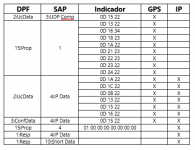lx2005
BG5BYZ
Hello, everyone:
Recently I've been trying to receive the traffic police in my city. Unfortunately, since I'm not in North America, the RR database is of no use to me.
I already know some facts about the system. There are dozens of frequencies in 360MHz to 370MHz band, and I have written them down. And I decoded some of the frenquencies with DSD+ and the scanner(conventional mode) without problems, so they are not encrypted.
Here are the things I'm trying to do:
Figuring out the frequencies, and then program my UBCD3600XLT scanner in trunk mode.
My understandings are: 1.find all frequencies 2.distinguish different systems/sites 3.program frequencies 4.use LCN finder to figure out LCNs is that correct?
But now I have a few problems. First, both DSD+ and the scanner tell me that they are all Tier3 systems(it says 'DT3'), so how to identify the exact system type(i.e con+, cap+, etc)? And I cannot tell the difference between control channels and voice channels. Almost all the channels brocast continuously, and when I try to use DSD+ to decode some of them, it shows idle most of the time, sometimes I can get audio. So do I need to distinguish control/voice channels to program? Do I need to distinguish different systems/sites to program?
Also, hear is a screenshot shows the busy band.

Thank you for any help. And sorry for my English, since I am not a native speaker.
Recently I've been trying to receive the traffic police in my city. Unfortunately, since I'm not in North America, the RR database is of no use to me.
I already know some facts about the system. There are dozens of frequencies in 360MHz to 370MHz band, and I have written them down. And I decoded some of the frenquencies with DSD+ and the scanner(conventional mode) without problems, so they are not encrypted.
Here are the things I'm trying to do:
Figuring out the frequencies, and then program my UBCD3600XLT scanner in trunk mode.
My understandings are: 1.find all frequencies 2.distinguish different systems/sites 3.program frequencies 4.use LCN finder to figure out LCNs is that correct?
But now I have a few problems. First, both DSD+ and the scanner tell me that they are all Tier3 systems(it says 'DT3'), so how to identify the exact system type(i.e con+, cap+, etc)? And I cannot tell the difference between control channels and voice channels. Almost all the channels brocast continuously, and when I try to use DSD+ to decode some of them, it shows idle most of the time, sometimes I can get audio. So do I need to distinguish control/voice channels to program? Do I need to distinguish different systems/sites to program?
Also, hear is a screenshot shows the busy band.

Thank you for any help. And sorry for my English, since I am not a native speaker.



